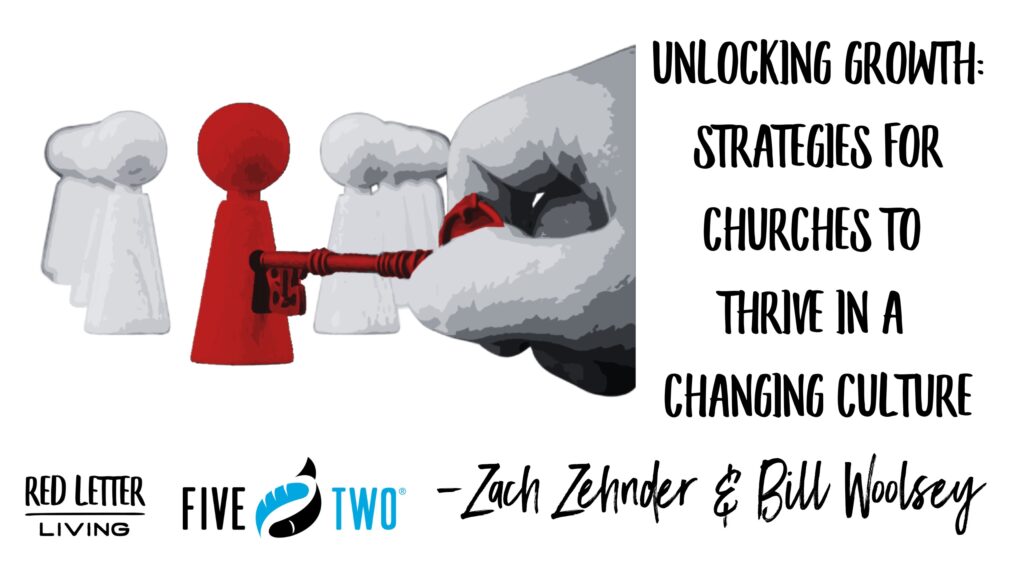

2500 years ago, the Greek philosopher Heraclitus said, “The only constant in life is change.” While change may be inevitable, how we deal with the changes in this world can be drastically different. A challenge we face in church leadership is how do we bring the unchanging life-giving message of Jesus to a world that will never stop changing.
When I think of someone on the frontlines of helping churches navigate change, I think of Bill Woolsey. He’s the founder and leader of FiveTwo. In today’s blog, Bill will discuss one of the four changing cultural trends that churches must pay attention to. For further discussion on this and three other cultural trends, I invite you to join us for a FREE webinar where I’ll interview Bill Woolsey on June 20th. It’s called Church Growth in 2024: Mastering the Four Biggest Cultural Trends.
Without further ado, here are Bill’s words.
Depending on the expert you talk to, our society experienced anywhere from 30-60 years of change during and coming out of the pandemic.
If you’re a pastor or leader within your congregation, my guess is you’re nodding your head. Emphatically even.
And you’ve probably been experiencing this first-hand for a while now. Maybe in the form of fewer worshipers, fewer volunteers, fewer dollars and less certainty.
As our culture continues to change rapidly, it might feel easier to hold your course (especially given budget, time, people constraints). But Jesus calls us to remain accountable for what’s happening in our communities. He does not intend for your church to ignore these changes.
We believe your church can grow, even in our rapidly changing culture.
But we also know navigating the dramatically shifting culture feels overwhelming. And you probably have one hundred questions. How do we stay relevant within our community? Where will the resources come from? Where do I even start? Just to name a few.
That’s why FiveTwo helps churches use entrepreneurship to grow by walking your entire congregation through a proven, 2-year process.
Since 2015, our one-of-a-kind training has equipped a variety of churches to pivot to the changes around them in ways that re-engage their community with the gospel. When this happens, churches thrive.
Through our listening and learnings, we’ve put together a free, comprehensive guide on what we consider the top cultural trends churches should be paying attention to. The churches we’re working with that align their congregation and ministries through the lens of these trends are thriving.
I encourage you to use this resource with your team to help determine where your congregation stands in the midst of all these changes.
Our prayer is that, by pivoting your congregation and ministry in response to these trends, you’ll re-engage your community, create tremendous impact, and experience lasting growth.
Let’s cover one of the biggest trends that everyone loves to hate.
Consumerism has radically shifted people’s (including yours) expectations about all areas of their life.
A consumer culture means the customer is at the center, and he or she is making the decisions, deciding what is and is not important. And if you’ve ever found yourself making decisions based upon your family’s needs, what’s good for your schedule, what you like or don’t like, then you, my friend, are a consumer. Are you an Amazon Prime member? Yup? Consumer.
One of the largest areas impacted by our consumer-driven culture is education.
Education has shifted from mass production to mass customization. Our consumer-driven culture demands choices for our education systems.
And the pandemic only accelerated this trend.
Since 2020, public school enrollment has dropped by 15%. Charter school enrollment is up by 36%, school choice by 25%, private schools by 22%, and micro school enrollment has increased by 50%.
In the 90s homeschooled students were few and far between. Now? Pretty much mainstream.
Have you thought about how your church can take advantage of this trend? With a small pivot, could your church be your community’s intersection of education and faith?
We’ve worked with churches who are stepping up in meaningful ways, offering advice, resources, and a place to belong for families exploring all the new education alternatives.
In our consumer culture, convenience is king. Churches have a special opportunity right now to create convenience while also providing support for families deciding which educational path is right for them.
Is your church tuning into what families need and want given all that’s changed?
Churches like Trinity Galewood just outside Chicago are doing this really well.
Last September, Trinity launched their No School Fun Day program that provides elementary and junior high students with a safe, engaging place to go when the school is closed.
Not only do the students look forward to No School Fun Day, Trinity’s congregation members, from college students to the retired, are excited to show up to serve.
From site leader, Eric Hawley:
“November was the biggest success. We had 46 kids show up and 19 volunteers.
Every week, kids from the school will ask me, “Is the church open today??” and “When’s the next No School Fun Day?” How cool is that? They want to get to the church. And that’s what they call it. They call it ‘The Church’.
They know the pattern. They want a place to hang out. And I think a big part of it is they’re looking for a space to belong, and the church is providing that.”
“My daughter wakes up early to get here! It starts the same time as school, and she’s always late to school!”
Many of these families have not been to church since COVID. In our rapidly changing culture, No School Fun Day is a way for the community to experience the love of Jesus while also being a stepping stone back into church.
In our consumer-driven culture, how convenient are you making it for people to get to Jesus? In a culture where Sunday morning worship is no longer a priority, how are you shifting your ministries so your neighbors can meet Jesus where they live?
Recognizing and responding to a changing culture doesn’t mean you’re selling out.
When your church is mobilized outside of its walls, communities are cared for and God’s kingdom grows.
We want your church to be there for your community for years to come. It’s what Jesus wants too.
As our culture continues to shift, what if we thought of every day as a new opportunity to bring resilience and sustainability to your church? How great would that shift be?
To read about the other trends your church should pay attention to – Post-Christian Reality, Mental and Physical Health, and Women Driving Spiritual Decisions – download our resource at fivetwo.com today.
In our rapidly changing culture, FiveTwo’s proven Strategic Growth Process, gives congregations what they need to launch ministries like the No School Fun Day. Ministries that meet the needs of a changing society, while also bringing them closer to the gospel.
Our certified catalysts walk with churches for two years, ensuring that people and ministries are aligned for growth.
Catch Bill Woolsey from FiveTwo on the Red Letter Living webinar on June 20, 2024. He’ll be talking about Four Cultural Trends Thriving Churches Address and sharing case studies of real ministry leaders successfully navigating these four trends.
Don’t miss out, register now.
